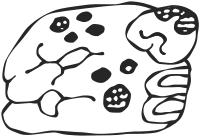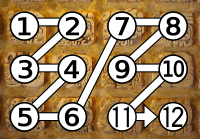How Did The Maya Use Writing To Represent Activities In Their Culture
This lesson was reported from:
Adapted in part from open sources.
- What is the difference between a phonetic sign and a logogram? Which one does English apply?
- Why are examples of Maya books so rare?
- Was reading and writing likely a skill practiced by common or poor Maya? Can you think of whatsoever modernistic professions similar to that of scribe?
The Maya writing system (sometimes calledhieroglyphs from a superficial resemblance to the Ancient Egyptian writing) is a logosyllabic writing system, which ways that it combines phonetic signs (or glyphs) representing sounds and syllables with logograms – glyphs representing entire words. While English uses 26 letters, x numerals, and various marks of punctuation, Maya writing is much expansive. At whatever one time, no more than than around 500 glyphs were in use, some 200 of which (including variations) were phonetic.
For instance, this is the Maya discussionB'alam – "jaguar" – written logographicaly with the jaguar caput glyph standing for the unabridged word:

The 2d glyph block writes the word phonetically using the three syllable signsBA,LA andMA:

Both are pronounced b'alam and carry the same significant.


The Maya writing system is one of the outstanding achievements of the pre-Columbian inhabitants of the Americas. Information technology was the most sophisticated and highly developed writing system of more than a dozen systems that developed in Mesoamerica.The earliest inscriptions in an identifiable Maya script appointment dorsum to 300–200 BC.
Unlike our modern base of operations 10 arrangement, the Maya used a base of operations 20 (vigesimal) system. The very concept of a vigesimal system probably stemmed from the full set of man digits: the term for "person," winik, is duplicate from that for a unit of "twenty."
The bar-and-dot counting system that is the base of Maya numerals was in employ in Mesoamerica by 1000 BC; the Maya adopted it past the Late Preclassic, and added the symbol for zero. This may have been the primeval known occurrence of the idea of an explicit zippo worldwide, although it may have been predated past the Babylonian system. The earliest explicit use of zero occurred on Maya monuments is dated to 357 Advert.

The Maya script was in utilise upward to the arrival of the Europeans, with its use peaking during the Classic Catamenia.In excess of 10,000 individual texts take been recovered, mostly inscribed on stone monuments, lintels, stelae and ceramics.The Maya also produced texts painted on a form of paper manufactured from candy tree-bark generally now known by its Nahuatl-linguistic communication proper nounamatl used to produce codices. The skill and knowledge of Maya writing persisted among segments of the population right up to the Spanish conquest. The knowledge was subsequently lost, as a result of the impact of the conquest on Maya club.

In an effort to suppress the Maya religion and to forcibly convert the Maya to Christianity, the Catholic Church building and colonial officials, notably Bishop Diego de Landa, destroyed Maya texts wherever they found them, and with them the knowledge of Maya writing. By chance three pre-Columbian books dated to the Postclassic catamenia have been preserved. These are known as theMadrid Codex, theDresden Codex and theParis Codex.A few pages survive from a fourth, theGrolier Codex. Archaeology conducted at Maya sites often reveals other fragments, rectangular lumps of plaster and paint fries which were codices; these tantalizing remains are, however, also severely damaged for whatever inscriptions to have survived, with nigh of the organic cloth having decayed.
Our knowledge of aboriginal Maya thought must correspond only a tiny fraction of the whole picture, for of the thousands of books in which the full extent of their learning and ritual was recorded, merely four accept survived to modern times (as though all that posterity knew of ourselves were to be based upon three prayer books and 'Pilgrim's Progress').
—Michael D. Coe,The Maya, London: Thames and Hudson, 6th ed., 1999, pp. 199–200.

According to Spanish accounts, Maya books independent histories, prophecies, maps, tribute ledgers, songs, scientific observations, and genealogies – but simply four examples of Maya books accept survived to the modern day, and they are all ritual/religious books. Painted pictures and carvings depict Maya books with jaguar-skin covers, painted by specialized scribes using brushes or quills dipped in conch vanquish inkpots, but as far equally nosotros can tell in the modern day, none of these material artifacts has survived the Castilian conquest or the humid jungle.
The decipherment and recovery of the knowledge of Maya writing has been a long and laborious process.Some elements were first deciphered in the belatedly 19th and early 20th century, more often than not the parts having to do with numbers, the Maya agenda, and astronomy. Major breakthroughs were fabricated from the 1950s to 1970s, and accelerated rapidly thereafter. By the end of the 20th century, scholars were able to read the majority of Maya texts, and ongoing piece of work continues to further illuminate the content.
Scribes and literacy
 Commoners were probably illiterate; scribes were drawn from the aristocracy. It is not known if all members of the elite could read and write, although at to the lowest degree some women could, since in that location are representations of female person scribes in Maya fine art. Maya scribes were chosenaj tz'ib, meaning "one who writes or paints." Although the archaeological record does not provide examples of brushes or pens, analysis of ink strokes on the Postclassic codices suggests that it was applied with a brush with a tip fashioned from pliable hair. There were probably scribal schools where members of the elite were taught to write.
Commoners were probably illiterate; scribes were drawn from the aristocracy. It is not known if all members of the elite could read and write, although at to the lowest degree some women could, since in that location are representations of female person scribes in Maya fine art. Maya scribes were chosenaj tz'ib, meaning "one who writes or paints." Although the archaeological record does not provide examples of brushes or pens, analysis of ink strokes on the Postclassic codices suggests that it was applied with a brush with a tip fashioned from pliable hair. There were probably scribal schools where members of the elite were taught to write.
Although not much is known well-nigh Maya scribes, some did sign their piece of work, both on ceramics and on stone sculpture. Usually, only a unmarried scribe signed a ceramic vessel, but multiple sculptors are known to have recorded their names on stone sculpture; eight sculptors signed i stela at Piedras Negras. However, virtually works remained unsigned by their artists.
Read more on this subject -> The Basics of Ancient Maya Civilisation ◦ The Ancient Maya in Time and Space ◦ Aboriginal Maya Guild ◦ The Maya Metropolis ◦ The Written Language of the Maya
Activities
- Employ this dictionary to write a short poem in the Maya script, using at least a dozen glyphs. Does composing in Mayan effect the experience of writing and reading?
- The Popol Vuh is one of the few remaining Maya stories dating to before the Castilian conquest. It was originally preserved through oral tradition throughout the Maya globe until approximately 1550 when it was written down. The Popol Vuh includes the Mayan cosmos myth, beginning with the exploits of the Hero Twins Hunahpú and Xbalanqué. Read some of an English translation of the Popol Vuh, then cull a scene to reenact in a iii-5 infinitesimal skit or video in front of your grade.
- Write an essay that compares and contrasts the 16th century Spanish conquistadors and the 21st century Taliban.
- Research the Caste War of Yucatán, which occurred in Mexico'due south Yucatan Peninsula in the nineteenth century. Have inspiration from the form and mode of the Dresden Codex to tell the story of this late menstruum Maya resistance.
- Choose whatsoever section from this unit of measurement and develop a lesson – in the grade of a presentation, a storybook, or a worksheet – that teaches younger students nearly the Maya. Make sure the fabric is age appropriate in content and approach, and create some unproblematic questions to cheque your audition'due south agreement.
Further Reading
The Maya (People and Places) by Michael Coe.
Ancient Maya by Barbara Somervill.
1491: New Revelations of the Americas Before Columbuspast Charles C. Isle of man.
THIS LESSON WAS INDEPENDENTLY FINANCED BY OPENENDEDSOCIALSTUDIES.ORG.
If you lot value the free resources nosotros offer, please consider making a small-scale contribution to keep this site going and growing.
You can actually visit parts of the globe featured in this lesson:
A Guided Bout of Maya Mexico, 2017– Explore the ruins of Ek' Balam, Uxmal, and Chichen Itza, scramble through streets of colonial Merida, and sample the cuisine and civilisation of Mexico's Yucatan Peninsula. Supplementary photos and information on the Yucatan, by and present.
How Did The Maya Use Writing To Represent Activities In Their Culture,
Source: https://openendedsocialstudies.org/2017/11/28/the-written-language-of-the-maya/
Posted by: myersmarder.blogspot.com


0 Response to "How Did The Maya Use Writing To Represent Activities In Their Culture"
Post a Comment